Pros and cons of growing Tsitsak pepper: how to get a good harvest
The bitter tsitsak pepper has a sharp taste and excellent keeping quality. The name of this unpretentious vegetable in translation from the Armenian language is simply "pepper". It is very popular in Georgia and Armenia. To get a crop in regions with a less warm climate, you should know the peculiarities of its cultivation and care.
The content of the article
Characteristics and description of the variety
Tsitsak pepper is the result of folk selection. He prefers warm countries. In cool climates, it can also produce a good harvest if grown in a greenhouse.
Important! The plant loves the sun's rays and reacts poorly to location in the shade, therefore, the tsitsak should not be covered by other plants during growth and development.
There are not too many leaves on the pepper bushes, the stem is strong. It reaches a height of 70 cm. Pepper leaves are green, oblong in shape with a pointed tip.
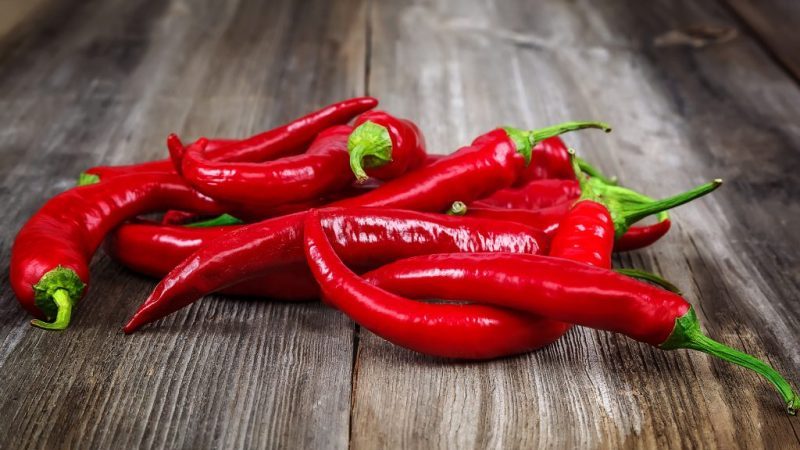
Pros and cons
Tsitsak has its advantages:
- high keeping quality of fruits - up to 95% of the total harvest is preserved;
- unpretentious care;
- resistance to diseases caused by fungi;
- high yield;
- ability to withstand frosts down to -20 ° С.
Cons of the variety:
- demanding for heat, which is why tsitsak is grown in greenhouses in an insufficiently warm climate;
- photophilous - if there is not enough light, this will noticeably affect the growth and development of pepper, as well as its yield.
Fruit characteristics and yield
The fruits have an elongated shape, slightly bent at the end. What is the difference between tsitsak and chili peppers? Outwardly, they are similar, but tsitsak is inferior in the degree of pungency. Fleshy cone-shaped fruits, covered with smooth skin. Peppers weigh up to 60 g, and grow in length up to 20 cm.
Reference. Pepper can coexist next to onions, dill and garlic.
Fruits ripen in the interval from 110 to 130 days after planting. Tsitsak is a fruitful pepper; on average, 2-4 kg of spicy fruits are harvested from 1 m². Fruits have different colors depending on the degree of maturity - from green and yellow to sharpening reds.
Tsitsak pepper is a pungent, aromatic variety that has a pleasant sweetish note that softens the pungency. Therefore, it can be eaten raw.
These peppers are eaten in different ways:
- fresh - in salads and snacks, meat dishes are especially good with it;
- pickled or salted;
- dried by grinding them into dust and using as seasoning.
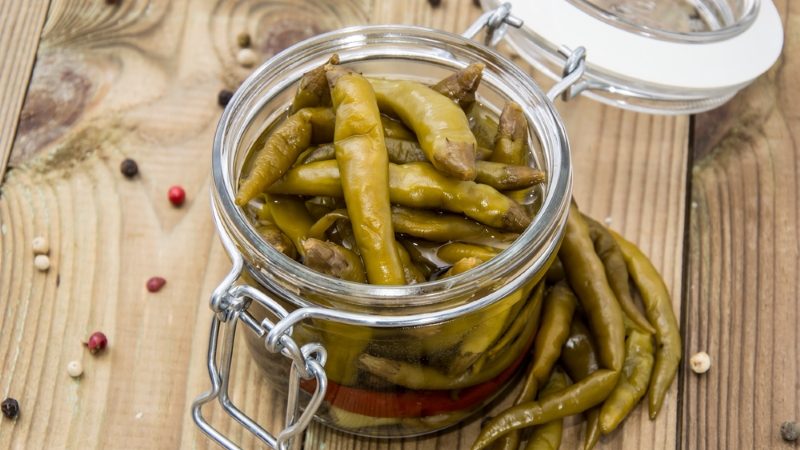
Growing
The cultivation of tsitsak has its own characteristics. The step-by-step process is as follows.
Selection and treatment of seeds
In order for the seedlings to appear together and the seedlings to grow strong and healthy, the pepper seeds should be pre-treated.
Important! To reject empty seeds, existing specimens are placed in water. Those that float to the surface should be thrown away, as they will not sprout.
Next, a solution is prepared from 2 g of ash and 1 liter of water. It is insisted during the day, stirring from time to time. The selected seeds in gauze are placed in the solution for 3 hours. Then the seeds are removed, washed and dried.
There is also an alternative seed treatment method that takes significantly less time. They are placed in a 2% solution of potassium permanganate. It is prepared in a proportion of 10 g of the drug per 1.5 l of water. The seeds are placed in the prepared solution for 20 minutes. After the procedure, they are taken out, washed and dried well.
Preparing the land for seedlings
The easiest way to get the optimum primer is to purchase it from the store. However, you can make the mixture yourself. There are several options:
- Mix peat with humus, sand and earth in equal parts.
- Combine the turf with earth, humus and sand in equal parts. Add ash to the resulting mixture at the rate of 0.5 kg of ash per 10 kg of the mixture. Next, mix the soil with drainage in a 1: 2 ratio. Add fresh turf and rotted compost to the mixture.
- Mix in equal parts humus with peat, adding superphosphate and potassium sulfate to the mixture.
Terms and features of sowing seeds
The best time to plant pepper is from February to March. The prepared soil mixture is filled in a box and depressions of 0.5 cm are made. The soaked seeds are placed in them, and covered with soil on top. To make the seeds hatch faster, they are covered with a special agrotechnical cloth or a simple film.
Reference. Pepper requires a certain temperature regime for growth and development. During the day, the temperature range can range from 23 to 25 ° C, and at night - from 13 to 15 ° C.
Seedling care
Once the planted seeds have sprouted, they should be planted. During the picking, the seedlings are planted in separate containers filled with peat and soil.
Attention! The picking process should be carried out carefully so as not to touch the delicate, still emerging root system of plants.
The soil in which the seedlings are located must be constantly moist. To do this, water the planted seeds regularly - every 2-3 days; after germination - every day. The tsitsak should be watered with water at a temperature of 20-25 ° C. To avoid fungal infections, you should water the seedlings under the root with biofungicides once every 2 weeks.
Tsitsak is transplanted into open ground 2-2.5 months after sowing seeds. 2 weeks before planting on the site, the seedlings begin to harden, reducing watering. Seedlings are taken out into the open air so that they get used to the ambient temperature. Plants are first exposed for 4-6 hours, then the time is gradually increased.
You need to plant seedlings in a pre-prepared area... To do this, in the fall, in the beds that are planned to be used for pepper, fertilize the ground with rotted humus and dig it up. Young plants are planted in the prepared soil in holes 5 cm deep and wide.
Important! Peppers should be transplanted together with an earthen clod, and then sprinkled with soil and watered.
Watering and feeding
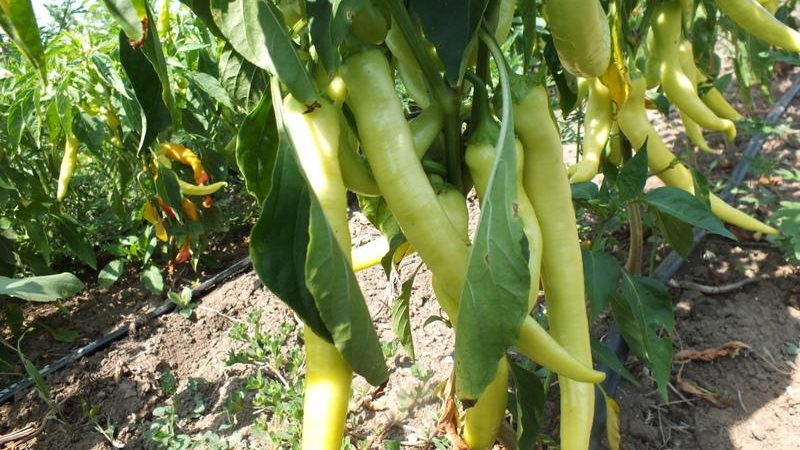
Plants should be watered regularly, taking into account the weather conditions. The soil should be moderately moist. To achieve this result, watered 2-3 times a week in the morning or evening.
Tsitsak needs to be fed with nitrogen fertilizers... When 3 leaves appear on the stems, phosphorus and potassium fertilizers are applied to the soil.
Reference. Additionally, you can use wood ash feeding 1-2 times a week to accelerate plant growth.
Hilling and loosening the soil
Loosening the soil is an essential ingredient for success in growing pepper. The soil should be loosened together with hilling. When the seedlings are actively growing, this is done about 5 times. It is important to take into account the period of plant development:
- during flowering, the soil should be loosened to a depth of 12 cm;
- when the seedling has formed ovaries, they loosen even deeper - 15 cm in depth;
- when fruiting begins, the loosening depth increases by another 10 cm.
If the peppers are planted close to each other, loosening should be avoided during the flowering period.
Bush formation rules
It is important for the tsitsak to form the bush correctly. This is done when the plant reaches 15-20 cm in height. During this period, branching begins in the pepper and the first bud appears at the place of branch formation, which is called the crown bud. Such a bud must be destroyed. This simple procedure will allow the pepper to develop better.
Further formation of the bush consists in pinching, removing unnecessary shoots that will not give ovaries.You should also remove leaves that create extra shade and do not participate in the nutrition of the set fruit. Thus, only strong stems with ovaries and fruits will remain on the bush, receiving a sufficient amount of light, heat and nutrients.
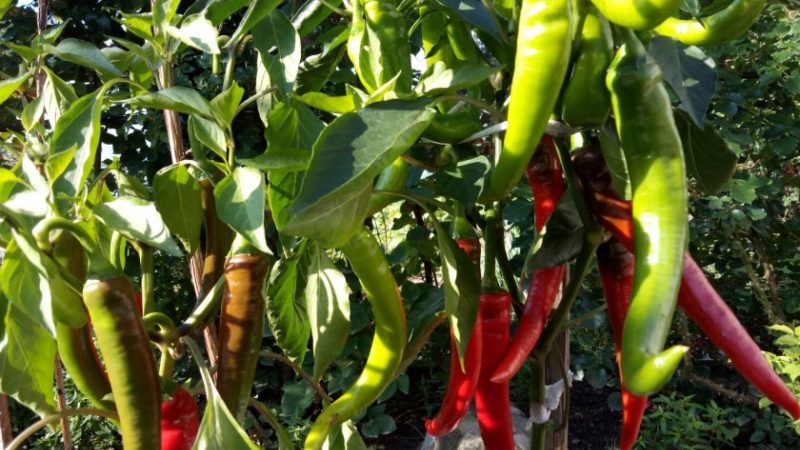
Prevention of diseases and pests
The tsitsak variety is resistant to many diseases. However, in case of improper care, garden pests can spoil the crop. Among them are the following:
- Aphid - an insect that sucks juices from peppers. As a result of its vital activity, the green mass of the plant turns yellow and dries up. To avoid crop losses, a solution of wood ash is used: 30 g of powder is diluted in 15 liters of water and half a glass of liquid soap is added. Shoots are sprayed with this tool.
- Spider mite. This pest lives on the back of the leaves, forming a whitish cobweb. Insecticides will help to combat it.
- Slugs. One of the most common garden pests can destroy almost all the fruits of your labor. Eating the leaves, the slug gradually deprives the pepper of normal nutrition. To get rid of it, use drugs "Karbofos" or "Keltan".
Reviews of gardeners
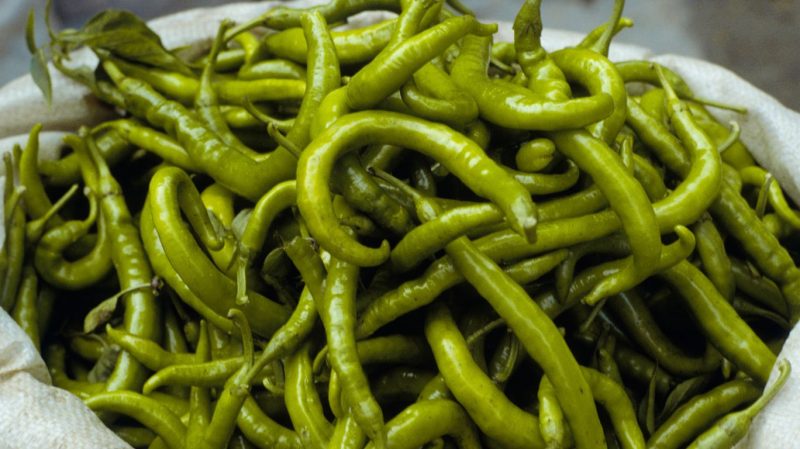
Experienced and novice gardeners, who planted tsitsak peppers in the plots, note the ease of care and an unusual, memorable taste.
Zoya Pavlovna, Taganrog: “Nice, moderately hot pepper! I planted it out of donated seeds quite late - at the very end of March. Of the five seeds planted in cups, four sprouted. Already at the beginning of summer, she transplanted seedlings into open ground, and at the end of July she harvested the first crop. It bears fruit perfectly: I collected as many as 63 peppers from four bushes! Basically, we went for salting and seeds. "
Sergey Borisovich, Moscow: “When I was visiting Tbilisi, I was treated to salty tsitsak. I liked it so much that I decided to grow such a pepper myself in my country house. From the purchased seeds, I first germinated seeds for seedlings, and only then planted them under a film on the site. Although the summer was cool and not very sunny, the harvest was good. The peppers themselves are spicy with a slight sweetish note. The whole family ate them with pleasure, and we even fermented a little. "
Ninulia, Pervomaisk: “A friend sent me the seeds along with a photo of her last year's harvest. The pepper grew quite sprawling, under 60 cm in height. There are many fruits on the bush, the peppers themselves are elongated, at least 20 cm in length. Unripe, they are green and then turn red. The pulp is not very fleshy. "
Read also:
The best sweet peppers for greenhouses in the Moscow region.
How to grow and care for ornamental pepper "Capsicum", and can you eat it?
Instructions for growing ornamental pepper "Little Miracle".
Conclusion
Tsitsak is an unpretentious culture. It only requires adherence to the general rules of planting, growing and care for peppers. The demand for light and heat is compensated by a high yield and long-term preservation of fruits.